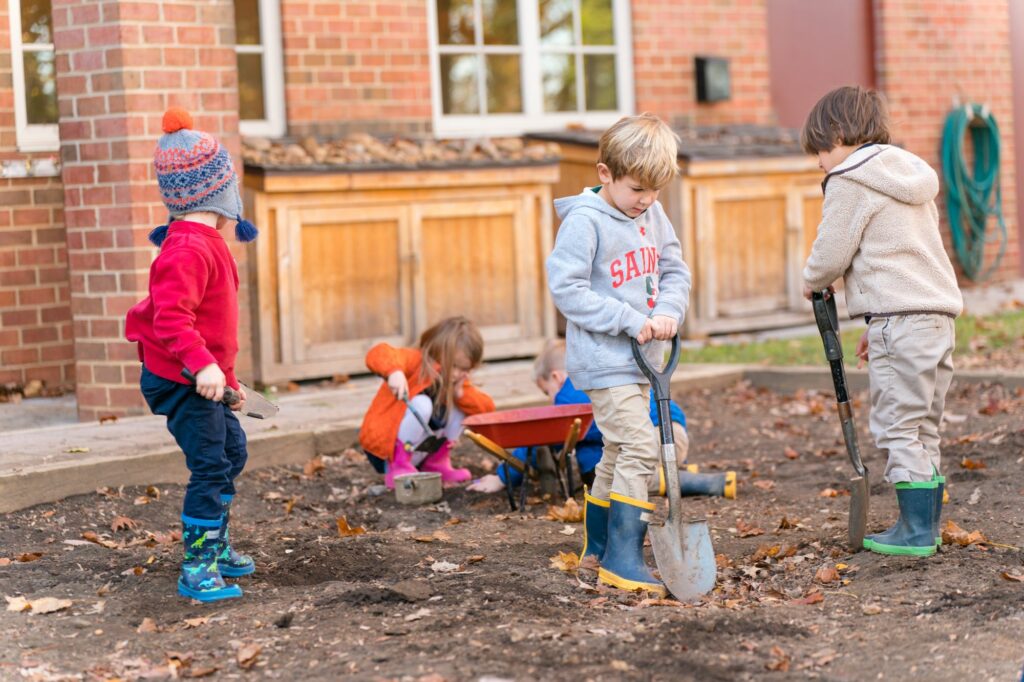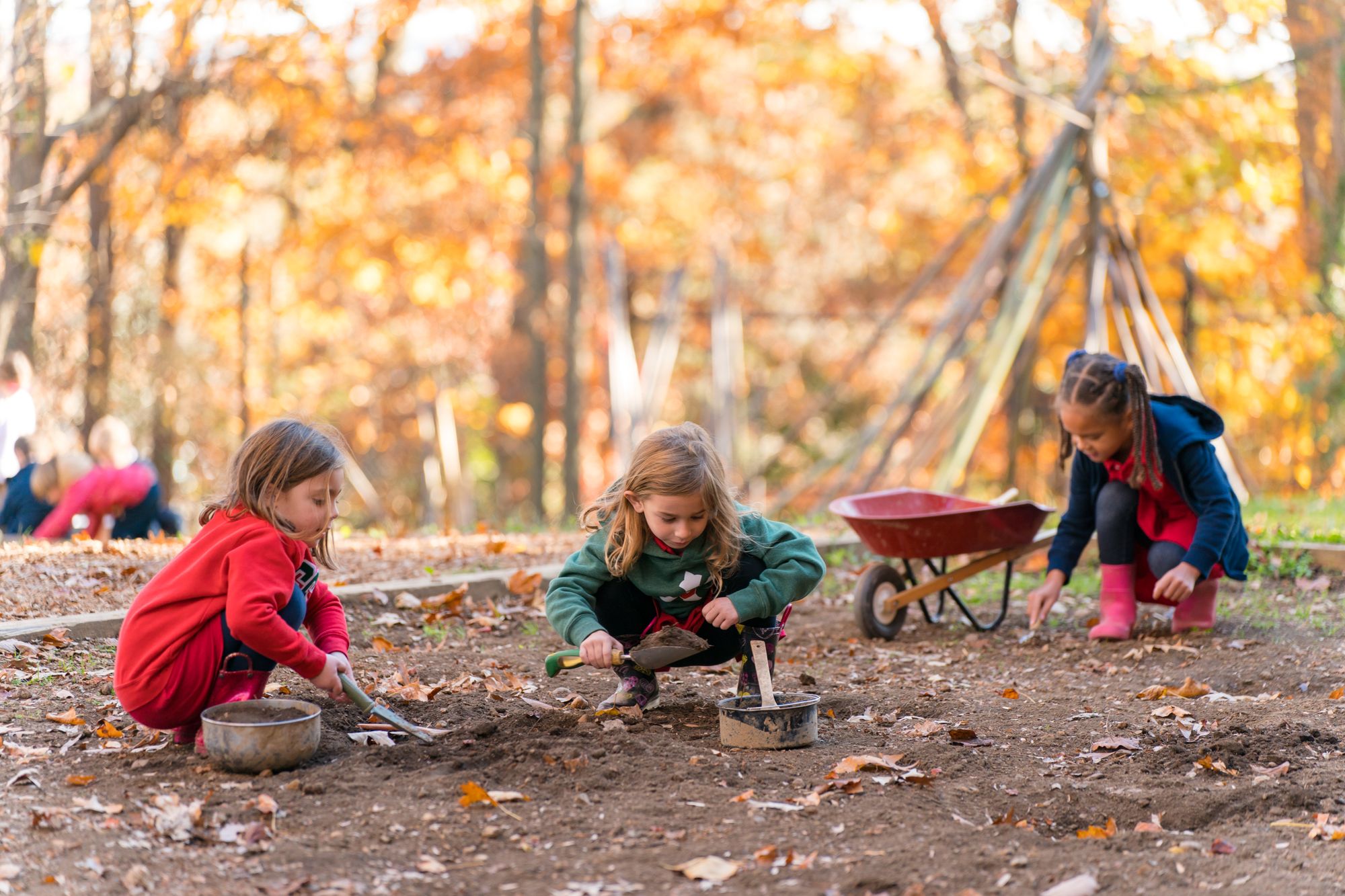Guided with intentional questions designed for learning, problem-solving, safety, and fun!
- Nature makes kids healthier: Teachers act more as a resource than an enforcer.
- Nature improves attention: The part of the brain that helps kids focus rests during natural play.
- Nature inspires active play: Nature itself is always changing and keeps kids interested.
- Nature helps kids get along: Leaders shift from the strongest (traditional play space) to the most creative and imaginative.
- Nature gives kids confidence: Important for children to learn about managing risks; this ultimately makes them less fearful.
- Nature helps kids see: Kids focus on everything from large landscapes to small bugs.
- Nature makes kids smarter (and happier) Mycobacterium vaccae, commonly found in soil, reduces anxiety.
- Children’s right to roam.


Here are examples of the natural items on our campus and how they benefit children:
Jump Stump Area and Balance Beams (straight and zig-zag). Both our areas offer spatial sense building, deepening balance capabilities, core-strengthening opportunities, executive functioning skill-building, and most importantly, FUN and JOY! When multiple students are using the courses at the same, wonderful exchanges are had as they problem-solve, hone communication skills, and enjoy the movement together.
Learning questions that allows students to problem-solve solutions: What can you do in this area? How can we jump safely? What should we do if someone comes jumping in our direction?
Soil Pit and Water Pump with gardening tools, digging tools, wheelbarrows, hand water pump, and buckets. This area allows students to explore one of nature’s gifts, mud, while also exerting their body in an intentionally physical way. Students experiment with the movement of soil, hone problem-solving skills as they work together and discuss their discoveries, and develop further inquiries based on their in-the-moment, hands-on explorations. In addition, they can explore concepts around science as they inquire and investigate about how to make water move and its uses with soil.
Learning opportunities: Children can name tools and demonstrate how each tool is used safely and its purpose (i.e. pointed shovel for digging; rake for moving soil). How can soil be moved safely? (throwing versus moving or wheelbarrow use) How do we safely pump water, and brainstorm ways to transport water and uses.
Outdoor Block Station, Life-Size Lincoln Logs Station, and Cabinet of Multi-sized Tree Cookies. Students experiment with constructing with blocks in the natural world, on tree stump tables, or on the dirt-laden ground which allows for the use of their imaginations at every step, investigation, collaboration, hearing multiple viewpoints, and planning and execution based on these, and the physical engagements of carrying and building with larger-scale hollow blocks and tree cookies.
Learning opportunities: What and where shall we build? How can we safely carry blocks to and from sheds? How many students needed to safely carry various-sized blocks? Where do we put building supplies away organized by size or shape?
Creation Station which provokes students’ curiosity to create with open-ended materials such as three sizes of bamboo sticks, burlap, rope, and twine all starting with a base of a tripod stand made from three sturdy branches embedded in the ground. Children build lifelong executive functional skills as they think of a vision, make a plan for that vision, construct, revise and edit, collaborate, and problem-solve along the way. This year, students have created everything from teepee-like huts to houses with baby cribs, to spaceships, to swing sets using the various offered materials.
Learning opportunities: How many students needed to safely carry the different lengths of bamboo? Brainstorm creation ideas to get creativity going…
How should we care for bamboo?
Magnetic Ramp Wall and Ball Ramp Materials where scientists are invited to build, experiment with ramps, tunnels, and balls of various sizes, materials, and shapes. This involves deepening science, mathematical, and social skills all while students believe it’s simply all about the play, which is what we want- the hidden learning threaded through the simple and pure joys!
Musical Wall and Chime Units for children to recognize music can be made and created with not only instruments but also various items in their relevant and everyday world. Students can investigate pitches, harmony, sound, and noise with various objects, utensils, and materials. In addition, a band can be created as the music makers also explore sound, and volume, and how different materials can ignite different levels of sound as they ding and bang on the two chime units.
Learning questions:
What sounds do you predict each will make? What utensils can be used for making sound and what is the safe strength to use to bang without damaging objects and musical instruments, as well as friends in the same area?

The Log Rolling Hill offers intense gross motor building as students carry, push, and roll logs of assorted thicknesses and lengths. Students get the much-needed physical input and output that helps recharge their vestibular systems and energize their minds, making learners alert, more attentive, and enabling healthy physical exertion crucial to the highest learning potential.
Pertinent and Potential Questions:
Have students demonstrate safe and effective ways to get the logs up the hill (carrying, rolling teamwork, etc)
Have students brainstorm and generate safe ways to keep logs at the top of a hill (sitting on, putting feet in front of, holding with hands, etc)
Brainstorm safe ways to start (waiting until everyone is up that is rolling and waiting to go get it until all logs roll and down)
Observation Station provides the chance for students to sit back and appreciate the work of peers, as they can perch upon wider logs at tables made from large tree stumps. Students can create observational drawings, make verbal observations, acquire or hone skills from watching peers in action, and socialize while engaging in the natural world and outdoors.
Pertinent and Potential Questions:
Brainstorm what and why students might want to sit and watch (i.e. how to build something or use materials others are already using)
Brainstorm other uses: eating a snack, observational drawing, reading, chatting, etc)
